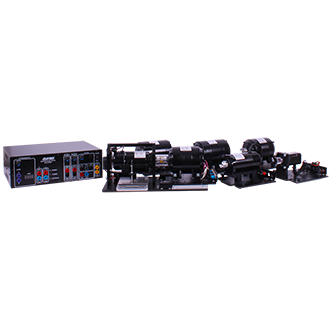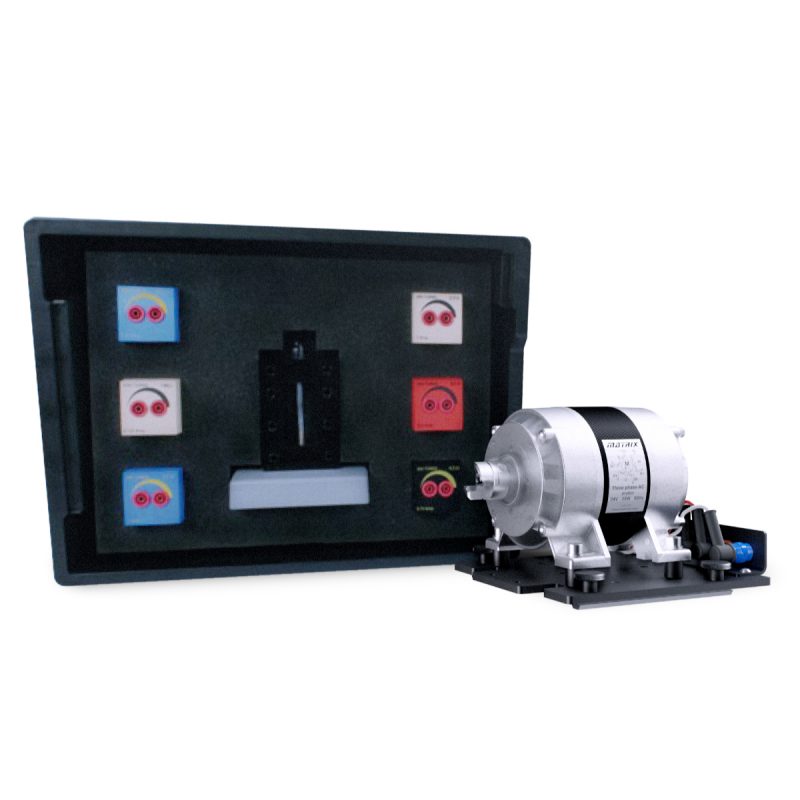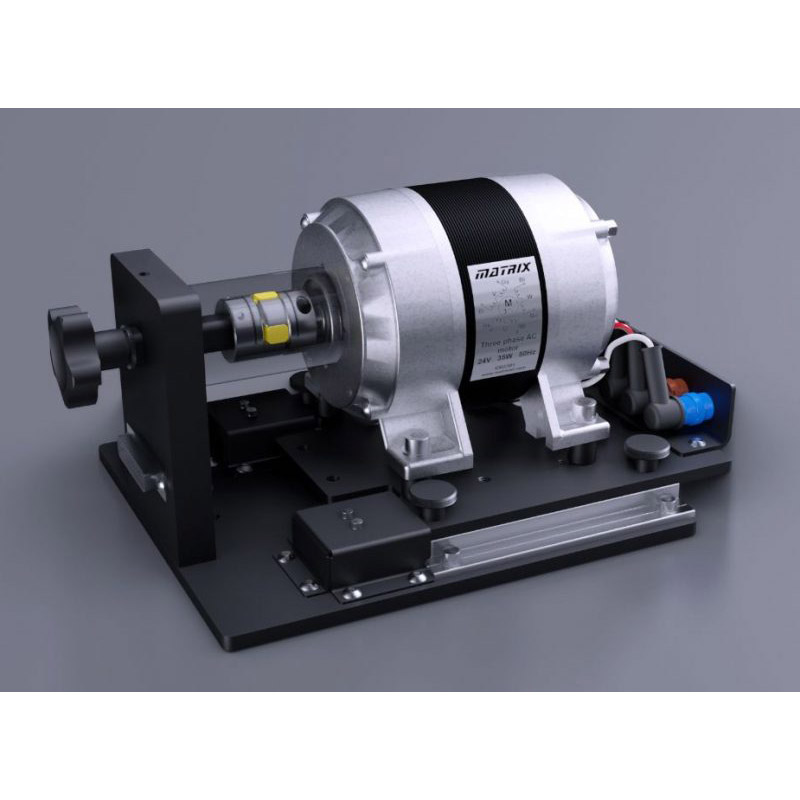Description
The system includes:
- Swinging arm dynamometer, permanent magnet DC machine, compound machine, series machine, three-phase induction machine, single-phase induction machine
- Machines operating off 24V AC or DC
- A computer-controlled system
- Electronic measurement of voltage, current and power in DC and AC
- AC & DC power supply single and three-phase with variable frequency
- Small footprint machines
- Tray-stored equipment for increased portability
- Full documentation and experiments
Equipment provided includes:
- Swinging arm DC dynamometer rig with manual or electronic torque measurement and encoder
- DC permanent magnet motor
- Shunt-wound field commutator motor
- Series wound field commutator
- Three-phase Induction Motor
- Single-phase Induction Motor
- SCADA measurement unit with in-built:
- Resistance chain for loading dynamometer
- Capacitance chain for motor series capacitance – start run
- Internal voltmeters
- Internal Tachometer
- Internal torque sensor
- Internal ammeters
- Internal protection circuitry
- Balance
- Leads
The Dynamometer is made up of a long-shafted Permanent Magnet DC machine free rotating between bearings mounted in a cradle. One side of the machine can be coupled to any of our test machines using a push-fit safety coupling housed in a plastic tube which ensures that no moving parts are accessible. The Dynamometer cradle takes torque measurements in both directions of rotation: anti-clockwise with a spring balance, and clockwise with a strain gauge linked to the control unit. It is fitted with two 4mm shrouded safety connectors which are used to add an electrical load to the machine and are also used as a DC machine (24V 50W) when testing machines as generators.
Overview:
Main Features
- Safe Operation; all moving parts covered
- Operates of 24V power, AC or DC
- Use manual or full PC controls for the motors
- Measure voltage, current, and power in DC and AC
- All machines are small footprint and low power
- Equipment can be easily stored and packed away
PC Software
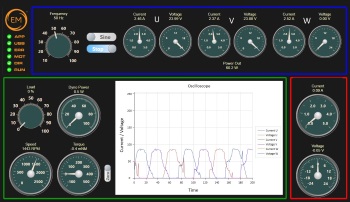
Three-phase control software with integrated oscilloscope.
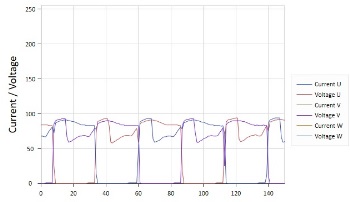
Close up of oscilloscope plot – users can select from one of 14 on-board instruments.
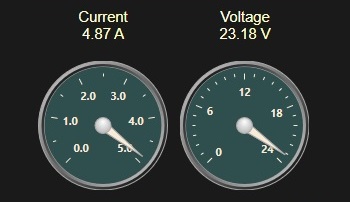
Gauges show key values such as current and voltage.
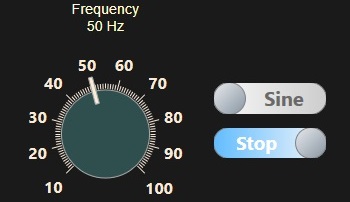
Set output frequency and waveform type – in this case, digital or pseudo-sine.
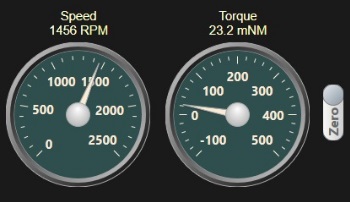
Software allows you to monitor RPM and torque in real-time.
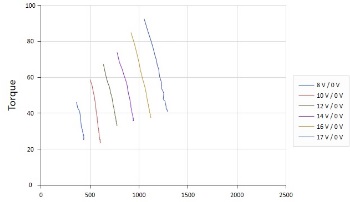
Automatic speed-torque graph for any of the machines can be generated by the software.
The system is designed to be used manually or via a connection to a laptop or PC. Above is a range of screenshots showcasing the ways the proprietary software can be used to control each type of machine in the range. Through experimentation, users can review the results of altering the voltage, load etc of each machine and the subsequent effect this has on each machine’s current, torque etc. over time.
Control Box
At the heart of both manual and PC control of the machines is our control unit. The control unit houses all of the electronics including motor drivers, to control the modern electrical machines training system.
The aluminum cradle which houses our dynamometer features a rugged and safe sliding mechanism in to which each of the other six motors in the range fix into position. The motor coupling meets the dynamometer in a protected housing and allows for safe study of each machine type at 24 volts.
Using with MATLAB
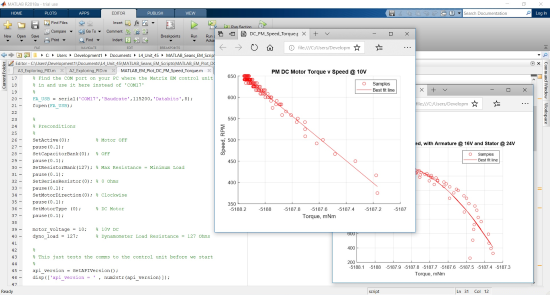
A suite of API calls are provided which allows the system to be used with both MATLAB and Labview software. This allows students to understand the characterization of electromechanical systems using mathematical formulae and to compare simulated results with real-world values.
Machines:
Dynamometer
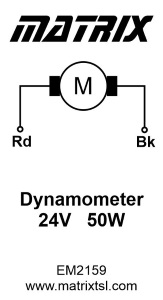
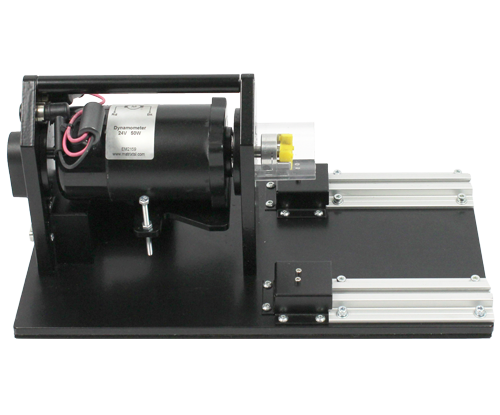
The Dynamometer is made up of a long-shafted Permanent Magnet DC machine free rotating between bearings mounted in a cradle. One side of the machine can be coupled to any of our test machines using a push-fit safety coupling housed in a plastic tube which ensures that no moving parts are accessible. The Dynamometer cradle takes torque measurements in both directions of rotation: anti-clockwise with a spring balance, and clockwise with a strain gauge linked to the control unit. The Dynamometer is fitted with two 4mm shrouded safety connectors which are used to add an electrical load to the machine and are also used as a DC machine (24V 50W) when testing machines as generators.
Brushless Motor
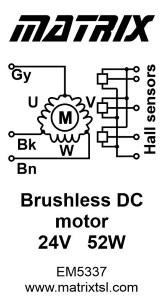
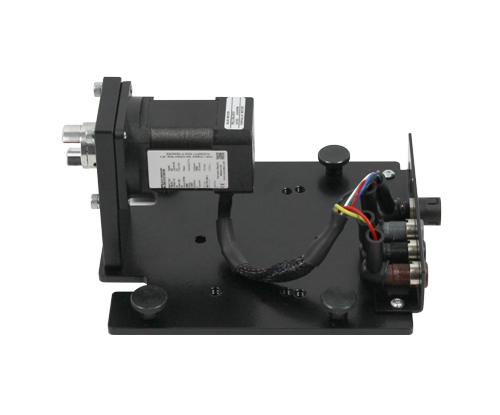
The Brushless DC motor is a small 24V 52 watt device with 8mm shaft and safety coupling. The 6 pole device is driven by a 24V three-phase supply and has Hall effect sensors to sense rotor position. The machine is fitted with 4mm connectors for drive and a 5-way connector for Hall sensors.
DC Motor
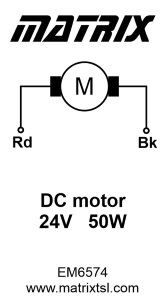
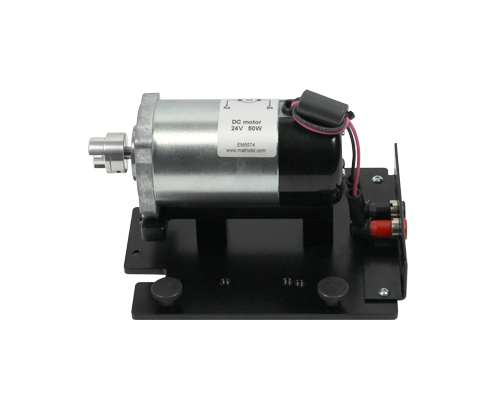
The 24V 50W Permanent magnet DC motor is a simple machine with two magnetic poles for the stator and a wound rotor with carbon brushes. The machine is fitted with 4mm shrouded connectors.
Universal Motor


The series motor can be driven from 24V AC or 24V DC and has a 2 pole wound stator and a wound rotor with carbon brushes. Rotor and stator connections are made on separate 4mm shrouded connectors.
Single Phase Motor
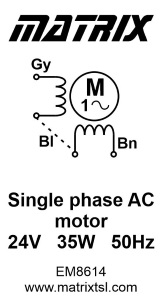
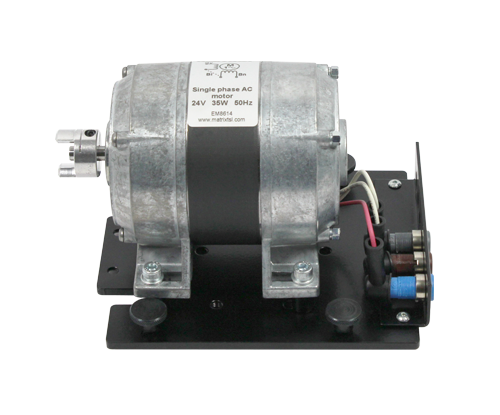
The single-phase 24V 35W induction motor has a 4 pole wound stator with two windings for start and run. A connection is provided on 4mm shrouded connectors with a common terminal, start terminal and run terminal. Requires an external capacitor (included inside the Control unit) to start rotation.
Shunt Motor
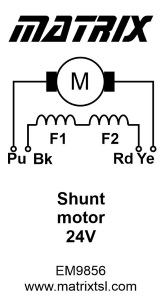
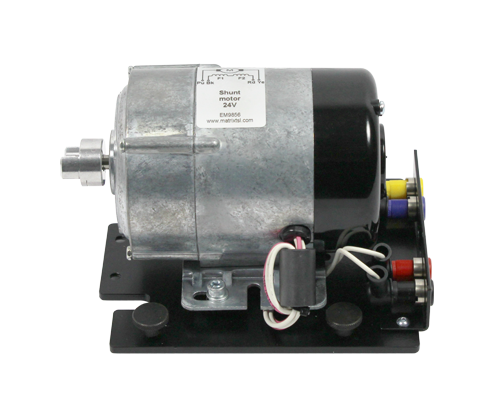
The shunt motor is a 24V device with a 2 pole wound stator a wound rotor with carbon brushes. Rotor and stator connections are made on separate 4mm shrouded connectors so that the field and armature can be excited by separate DC power supplies.
Three Phase Motor
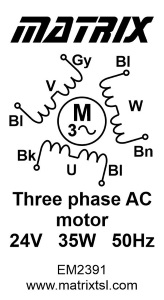
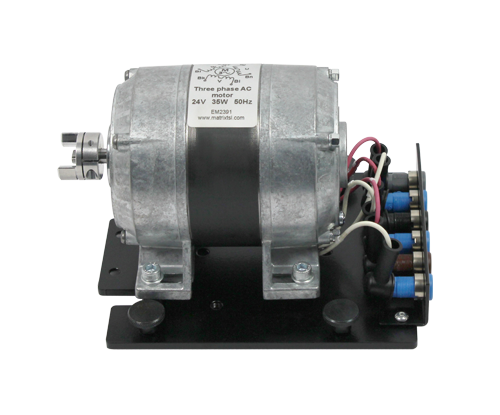
The three-phase 24V 35W induction motor has a 2 pole wound stator. Connection for each winding is provided on 4mm shrouded safety connectors.
Curriculum:
Electrical machines level 3 – BTEC unit 15
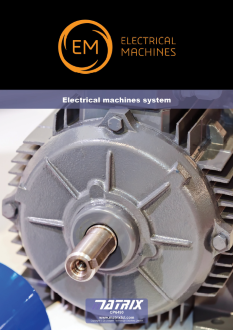
This learning resource – when used with the Matrix Modern Electrical Machines system – teaches students the basics of electrical machine operation, their speed/torque characteristics, relevant mathematical relationships including torque, power, and slip, and details of the circuits and power supplies needed to drive them. Machines include Dynamometer, DC motor, Dynamo, single and three-phase induction motor, shunt motor and series motor, Three-phase generator, and Brushless DC motor.
- Understand each type of motor and how it is constructed – paper exercise
- Understand each type of motor and how it is connected in circuit and what the circuits need to be
- Understand single phase induction motors and the use of start/run capacitors
- Understand torque and the use of a balance to measure torque
- Understand speed-torque curves for each motor and make a quick manual plot or a spreadsheet plot from taking manual readings
- Understand why different motors are used in different applications and how the speed/ torque graph dictates this.
- Understand the AC signals and how the motors in modern electrical machines are driven with square waves rather than sine waves.
- Understand RMS and what it means and how to calculate it
- Understand power in and power out and efficiency – measure the power using RMS V and I meters
- Understand back emf and how this limits motor speed in Series motors
- Get automatic motor speed-torque characteristics using software. Plot families of curves on Excel.
- Understand synchronous speed and slip in induction motors
- Understand three-phase generation from Brushless DC and how voltage out varies with speed.
Electrical installation level 3
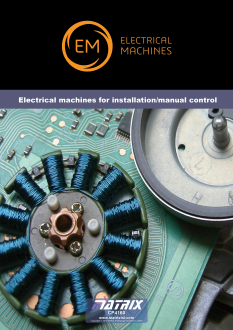
This learning resource – when used with the Matrix Modern Electrical Machines system – teaches Electrical Installation students the basics of electrical machine operation, their speed/torque characteristics and the circuits and power supplies needed to drive them. Machines include Dynamometer, DC motor, single and three-phase induction motor, shunt motor and series motor.
- Understand each type of motor and how it is constructed – paper exercise
- Understand each type of motor and how it is connected in a circuit and what the circuits need to be
- Understand single phase induction motors and the use of start/run capacitors
- Understand torque and the use of the balance to measure torque
- Understand rough speed-torque curves for each motor and make a quick manual plot or a spreadsheet plot
- Understand why different motors are used in different applications.
- Understand RMS and what it means
- Understand power in and power out and efficiency – measure the power using RMS V and I meters
MATLAB and electrical machines level 5 – university undergraduate year 2
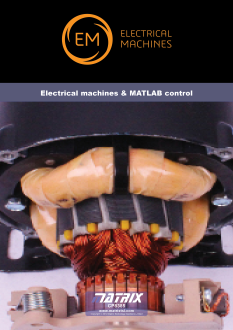
This learning resource – when used with the Matrix Modern Electrical Machines system – teaches students how to use MATLAB to measure the characteristics of electrical machines, how to define the characteristics using a mathematical model and to verify that model using test results. A full MATLAB compatible Application Programming Interface for the control unit is supplied. Machines include Dynamometer, DC motor, Dynamo, single and three-phase induction motor, shunt motor and series motor, three-phase generator, and Brushless DC motor.
- Generate a programme that gathers speed torque data for any machine
- Use MATLAB to derive a mathematical model for a motor.
- Test this model against real data.
- Create a new mathematical model for a different machine. Test this model against real data.
- Alter the Dynamometer resistance and predict the test results.
Electrical machines level 5 – university undergraduate year 2
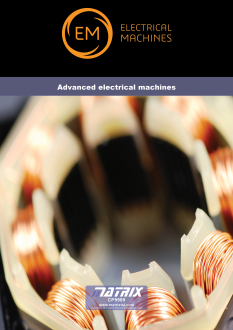
This learning resource – when used with the Matrix Modern Electrical Machines system – introduces students to more advanced concepts and models of electrical machines and focuses particularly on building equivalent circuits of machines. Machines include Dynamometer, DC motor, Dynamo, single and three-phase induction motor, shunt motor and series motor, three-phase generator, and Brushless DC motor.
- Derive the equivalent electrical circuit for a DC machine
- Use MATLAB to estimate the equivalent circuit for the induction motor. Test and iterate until the mathematical model works.
- Use a transformer to make a filtered three-phase power supply. Carry out tests on the induction motor for delta and star connections. Understand efficiency.
- Understand digital drive circuit options: six-step with open or short, square wave versus pseudo sine wave.
- Examine different drive algorithms of the three-phase induction motor and investigate the efficiency of each.

